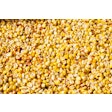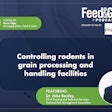On Jan. 25, at the International Poultry Expo /International Feed Expo in Atlanta, IFEEDER conducted a luncheon to update the media, donors and industry stakeholders about IFEEDER’s progress on its two year anniversary. IFEEDER, The Institute for Feed Education and Research, was launched at IPE/IFE in 2010 with great interest to the U.S. feed and food industries.
The mission of IFEEDER is “To Sustain the Future of Food and Feed Production Through Education and Research.” After two years of existence, it was time we came back and gave an update on the status of our endowment, and more importantly, what projects we have funded to date and how those projects are going. Remember, the need for someone to focus on education or research in our industry is critical. The American Feed Industry Association (AFIA) has its hands full with legislative and regulatory issues — all that it can handle. However, without significant increases in private research and education spending, we will never feed the projected 9.1 billion-plus population projected by 2050. The majority of that demand will come from the United States.
At this year’s luncheon, we shared some new facts. The USDA’s Economic Research Service (ERS) simulations indicate that if U.S. public agricultural R&D spending remains constant (in nominal terms – not adjusting for inflation) until 2050, the annual rate of agricultural TFP* growth will fall to under 0.75% and U.S. agricultural output will increase by only 40% by 2050. By comparison, average TFP growth over the last 50 years was 1.5% annually.
Under this scenario, raising output beyond this level would require bringing more land, labor, capital, materials, and other resources into production, and we know that’s unlikely to happen. Additional agricultural R&D spending will raise U.S. agricultural productivity and output growth. Raising R&D spending by 3.73% annually (offsetting the historical rate of inflation in research costs) would increase U.S. agricultural output by 73% by 2050. Raising R&D spending by 4.73 percent per year (1% annual growth in inflation-adjusted spending) would increase output by 83% by 2050 — in line with the need to double our food production by 2050.
The projects that IFEEDER has sponsored to date will make an impact. Consider the following projects, where IFEEDER has made a total of $195,000 of investments, leveraging another $1.5M of investments to move the research and education needle forward:
- National Academies’ Nutrient Requirements for Swine (Swine NRC)
- National Academies’ Nutrient Requirements for Beef (Beef NRC)
- Funded research to better define the impact of Salmonella and/or other pathogens in feed.
- Funded research for FAO Life Cycle Assessment (LCA) Model for Livestock.
- The ABC’s of Farming Coloring Book
- Adopt-a-Teacher Program to help educate school-aged children about animal agriculture
IFEEDER is very proud to announce that at our luncheon in Atlanta we received another $99,000 in donations to take our total to-date to over $1 million, well on our way to our two-year goal of $1.25 million in total donations. Our sincere ‘thank you’ goes to all those individuals and companies that have agreed to help sustain the future of food and feed production through education and research.
Visit www.ifeeder.org for more information about IFEEDER's education and research goals.
*TFP = Total Factor Productivity, an indicator of technological change and, thus, output.
Dean Warras is the President of Prince Agri Products and the Chair-Elect of IFEEDER. Previously he served as the Vice-Chair for IFEEDER.


















